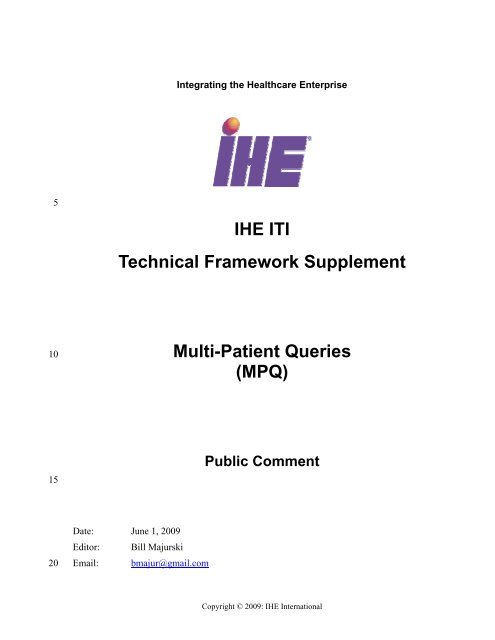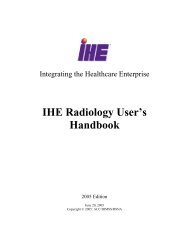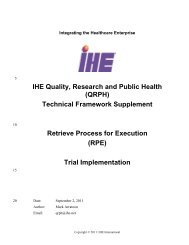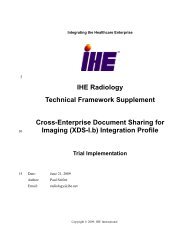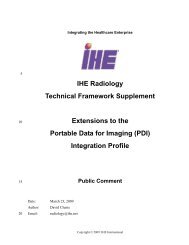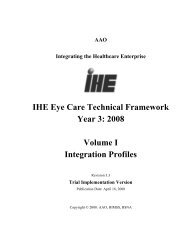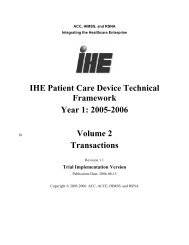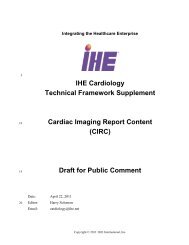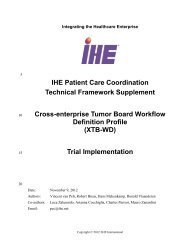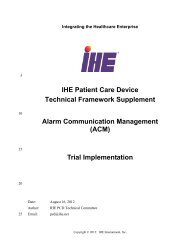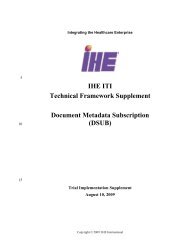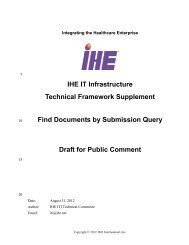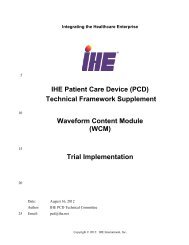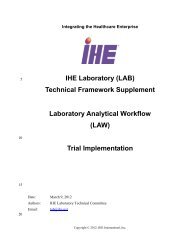IHE ITI Technical Framework Supplement Multi-Patient Queries (MPQ)
IHE ITI Technical Framework Supplement Multi-Patient Queries (MPQ)
IHE ITI Technical Framework Supplement Multi-Patient Queries (MPQ)
Create successful ePaper yourself
Turn your PDF publications into a flip-book with our unique Google optimized e-Paper software.
Integrating the Healthcare Enterprise<br />
5<br />
<strong>IHE</strong> <strong>ITI</strong><br />
<strong>Technical</strong> <strong>Framework</strong> <strong>Supplement</strong><br />
10<br />
<strong>Multi</strong>-<strong>Patient</strong> <strong>Queries</strong><br />
(<strong>MPQ</strong>)<br />
15<br />
Public Comment<br />
20<br />
Date: June 1, 2009<br />
Editor: Bill Majurski<br />
Email: bmajur@gmail.com<br />
Copyright © 2009: <strong>IHE</strong> International
<strong>IHE</strong> <strong>Technical</strong> <strong>Framework</strong> <strong>Supplement</strong> - <strong>Multi</strong>-patient <strong>Queries</strong> (<strong>MPQ</strong>)<br />
______________________________________________________________________________<br />
25<br />
This profile to the <strong>IHE</strong> <strong>ITI</strong> <strong>Technical</strong> <strong>Framework</strong> V5.0 is submitted for Public Comment<br />
between June 1 2009 and July 1 2009, per the schedule announced in December 2008.<br />
Comments shall be submitted before July 1 2009 to:<br />
http://forums.rsna.org under the "<strong>IHE</strong>" forum<br />
Select the "<strong>ITI</strong> Profiles for Public Review" sub-forum.<br />
Please use the Public Comment Template provided there when starting your New Thread.<br />
30<br />
The <strong>IHE</strong> <strong>ITI</strong> <strong>Technical</strong> Committee will address these comments and publish the Trial<br />
Implementation version in August 2009.<br />
Details about <strong>IHE</strong> may be found at: www.ihe.net<br />
35<br />
Details about the <strong>IHE</strong> <strong>ITI</strong> may be found at: http://www.ihe.net/Domains/index.cfm<br />
Details about the structure of <strong>IHE</strong> <strong>Technical</strong> <strong>Framework</strong>s and <strong>Supplement</strong>s may be found at:<br />
http://www.ihe.net/About/process.cfm and http://www.ihe.net/profiles/index.cfm<br />
40<br />
The current version of the <strong>IHE</strong> <strong>ITI</strong> <strong>Technical</strong> <strong>Framework</strong> may be found at:.<br />
http://www.ihe.net/<strong>Technical</strong>_<strong>Framework</strong>/index.cfm<br />
45<br />
These “boxed” instructions are for the author to indicate to the Volume Editor how to integrate<br />
the relevant section(s) into the overall <strong>Technical</strong> <strong>Framework</strong><br />
Replace Section X.X by the following:<br />
__________________________________________________________________________<br />
Rev. 1.0 - 2009-06-01 2 Copyright © 2009: <strong>IHE</strong> International
<strong>IHE</strong> <strong>Technical</strong> <strong>Framework</strong> <strong>Supplement</strong> - <strong>Multi</strong>-patient <strong>Queries</strong> (<strong>MPQ</strong>)<br />
______________________________________________________________________________<br />
50<br />
55<br />
60<br />
65<br />
70<br />
TABLE OF CONTENTS<br />
1 Introduction.............................................................................................................................. 4<br />
1.1 Profile Abstract................................................................................................................. 4<br />
1.2 Open Issues and Questions............................................................................................... 4<br />
1.3 Closed Issues .................................................................................................................... 4<br />
1.7 History of Annual Changes....................................................................................................... 7<br />
2.1 Dependencies among Integration Profiles ................................................................................ 8<br />
2.2.X <strong>Multi</strong>-<strong>Patient</strong> <strong>Queries</strong> Integration Profile.................................................................... 8<br />
X <strong>Multi</strong>-<strong>Patient</strong> <strong>Queries</strong> Integration Profile ................................................................................... 9<br />
X.1 Actors/ Transactions............................................................................................................ 9<br />
X.2 <strong>Multi</strong>-<strong>Patient</strong> Query Integration Profile Options .................................................................. 10<br />
X.2.1 Grouping Rules.......................................................................................................... 10<br />
X.2.2 Asynchronous Web Services Exchange Option......................................................... 10<br />
X.3 <strong>MPQ</strong> Process Flow............................................................................................................ 11<br />
X.3 Different technical queries for the use of <strong>MPQ</strong> ................................................................ 11<br />
X.3.1 Aggregated use and their corresponding queries....................................................... 11<br />
X.3.2 Detailed queries......................................................................................................... 12<br />
X.3.3 Capturing patient consent – informative value only.................................................. 13<br />
X.4 <strong>MPQ</strong> Security Considerations........................................................................................... 14<br />
3.Y <strong>Multi</strong>-<strong>Patient</strong> Stored Query ............................................................................................... 17<br />
3.Y.1 Scope ......................................................................................................................... 17<br />
3.Y.2 Use Case Roles .......................................................................................................... 17<br />
3.Y.3 Referenced Standard .................................................................................................. 17<br />
3.Y.4 Interaction Diagram ................................................................................................... 18<br />
3.Y.5 Security Considerations ............................................................................................. 22<br />
75<br />
__________________________________________________________________________<br />
Rev. 1.0 - 2009-06-01 3 Copyright © 2009: <strong>IHE</strong> International
<strong>IHE</strong> <strong>Technical</strong> <strong>Framework</strong> <strong>Supplement</strong> - <strong>Multi</strong>-patient <strong>Queries</strong> (<strong>MPQ</strong>)<br />
______________________________________________________________________________<br />
1 Introduction<br />
80<br />
This supplement that will be added to the <strong>ITI</strong> <strong>Technical</strong> <strong>Framework</strong> provides a means to do<br />
queries on multiple patients, based on pre-established meta-data. This supplement contains a<br />
new transaction, <strong>Multi</strong>-<strong>Patient</strong> Stored Query between a Document Consumer, and a Document<br />
Registry. The new transaction is based on the Registry Stored Query transaction (<strong>ITI</strong>-18), using a<br />
new query catalog. The multi-patient queries will allow clinical research, quality accreditation<br />
institutions and public health organizations to make sound decisions in their field of activity.<br />
The data to be aggregated, queried, and retrieved are pertaining to XDS Affinity Domains.<br />
1.1 Profile Abstract<br />
85<br />
90<br />
95<br />
Currently, the XDS stored query transaction defines a single catalog of queries, which require<br />
that either a single patient ID, a folder ID, or a submission set ID are present in each query.<br />
While the existing query catalog serves various healthcare integration workflows, there are other<br />
cases where aggregated queries, i.e. queries not constrained to a single patient, folder, or catalog,<br />
are necessary. The domain that is currently needing the aggregated queries is the QRPH (the<br />
Quality, Research and Public Health), where data needs to be combined so that a pattern can<br />
ensue. Examples in the three areas would be repurposing, secondary use, and monitoring<br />
population health.<br />
Quality accreditation organizations need to be able to aggregate data so that they can perform<br />
measurements of how institutions perform (author or healthcareFacilityTypeCode).<br />
Clinical Research needs to be able to combine the results of different patients in a clinical trial<br />
(typeCode).<br />
Public Health needs to have the means to make aggregated queries on certain fields such as<br />
eventCodeList in order to identify potential outbreaks and take appropriate decisions.<br />
1.2 Open Issues and Questions<br />
100<br />
1. Since a Document Consmer that supports this profile is likely to be a high risk target,<br />
should we mandate Secure Node<br />
1.3 Closed Issues<br />
105<br />
110<br />
1. This supplement is based on adding a new <strong>MPQ</strong> Document Registry actor and a <strong>MPQ</strong><br />
Document Consumer actor to XDS.b, as well as a new transaction, using a new query<br />
catalog complementing the Registered Stored Query <strong>ITI</strong>-18 in the XDS.b supplement,<br />
creating a new profile addressing the issue of aggregated queries.<br />
2. The security requirements will be different since they can be defined separately from the<br />
existing XDS Document Registry Actor. A security assessment needs to be done.<br />
3. In the Cross Enterprise Document Sharing XDS.b, the XDS.b Registry supports only the<br />
current query catalog and it must be possible to group it with the new <strong>MPQ</strong> Document<br />
Registry actor.<br />
__________________________________________________________________________<br />
Rev. 1.0 - 2009-06-01 4 Copyright © 2009: <strong>IHE</strong> International
<strong>IHE</strong> <strong>Technical</strong> <strong>Framework</strong> <strong>Supplement</strong> - <strong>Multi</strong>-patient <strong>Queries</strong> (<strong>MPQ</strong>)<br />
______________________________________________________________________________<br />
115<br />
120<br />
125<br />
130<br />
135<br />
140<br />
145<br />
4. The <strong>MPQ</strong> query can be done on a document or on a folder.<br />
5. Synchronous or asynchronous queries as applied to <strong>MPQ</strong> are not an issue as they are<br />
bound to Appendix V.<br />
6. The <strong>MPQ</strong> query should have at least one “key” parameter, but there can be other multiple<br />
parameters in order to serve the particular use cases. At least one parameter must be<br />
specified.<br />
7. There is a difference between querying directly for aggregated data for statistical<br />
purposes, and querying for detailed data for more advanced purposes. Policies are to be<br />
put into place to restrict access to these types of queries, meaning that certain individuals<br />
or categories of individuals, or certain institutions can have access to one or to the other.<br />
8. The aggregated queries for statistical purposes provide limited functionality. At this<br />
point in time the statistical function is limited to providing the sum. A list corresponding<br />
to the query with the UUID is provided. It is understood that the application performing<br />
the query will be responsible for counting. The implementation of this feature is left up<br />
to the implementers and it is out of scope of this profile.<br />
The ordering in the aggregated queries (for example by date) or will that be the user’s<br />
responsibility<br />
9. A mechanism for pseudonymization and how it should be used in the context of<br />
protecting the patient’s privacy, as well as providing a mechanism (when needed) to<br />
reverse it (traceability to the patient) is out of the scope of this profile.<br />
10. A homeCommunityID will not be added to the queries.<br />
11. A time out value for retrieving the documents/values is not part of this profile but it is an<br />
implementation issue.<br />
12. A mechanism for pseudonymization and how it should be used in the context of<br />
protecting the patient’s privacy, as well as providing a mechanism (when needed) to<br />
reverse it (traceability to the patient) should be described. Out of scope.<br />
13. How will <strong>MPQ</strong> be updated so that it can reflect properly the future modifications brought<br />
in the future to the Stored <strong>Queries</strong> Profile format changed to only show enhancements<br />
over Stored Query.<br />
14. The vocabulary used to code the metadata is assumed to be the same across communities.<br />
This is not an assumption that is correct at this point in time. Answer: No crosscommunity<br />
vocabulary assumptions are made.<br />
15. The multi-patient queries are applicable to XDS Affinity Domains but not to other local<br />
communities. However, this is an important case and it will be considered in future work.<br />
Answer: the extension of <strong>MPQ</strong> to Cross-Community environment has not yet been<br />
considered.<br />
__________________________________________________________________________<br />
Rev. 1.0 - 2009-06-01 5 Copyright © 2009: <strong>IHE</strong> International
<strong>IHE</strong> <strong>Technical</strong> <strong>Framework</strong> <strong>Supplement</strong> - <strong>Multi</strong>-patient <strong>Queries</strong> (<strong>MPQ</strong>)<br />
______________________________________________________________________________<br />
150 Volume 1 – Integration Profiles<br />
Glossary<br />
Add the following terms to the Glossary:<br />
__________________________________________________________________________<br />
Rev. 1.0 - 2009-06-01 6 Copyright © 2009: <strong>IHE</strong> International
<strong>IHE</strong> <strong>Technical</strong> <strong>Framework</strong> <strong>Supplement</strong> - <strong>Multi</strong>-patient <strong>Queries</strong> (<strong>MPQ</strong>)<br />
______________________________________________________________________________<br />
1.7 History of Annual Changes<br />
155<br />
<br />
Add the following bullet to the end of the bullet list in Section 1.7<br />
• Added the <strong>Multi</strong>-<strong>Patient</strong> <strong>Queries</strong> profile which allows aggregated queries to a registry.<br />
__________________________________________________________________________<br />
Rev. 1.0 - 2009-06-01 7 Copyright © 2009: <strong>IHE</strong> International
<strong>IHE</strong> <strong>Technical</strong> <strong>Framework</strong> <strong>Supplement</strong> - <strong>Multi</strong>-patient <strong>Queries</strong> (<strong>MPQ</strong>)<br />
______________________________________________________________________________<br />
2.1 Dependencies among Integration Profiles<br />
Add the following to Table 2-1<br />
160<br />
<strong>MPQ</strong><br />
Audit Trail and<br />
Node<br />
Authentication<br />
Each Document Registry actor<br />
and each Document Consumer<br />
shall be grouped with a Secure<br />
Node Actor<br />
Required to manage audit<br />
trail of exported PHI, node<br />
authentication and transport<br />
encryption<br />
<strong>MPQ</strong><br />
Consistent Time<br />
Each Document Registry actor<br />
and each Document Consumer<br />
shall be grouped with the Time<br />
Client Actor.<br />
To ensure consistency<br />
among document and<br />
submission set dates<br />
Add the following section to Section 2.2<br />
165<br />
2.2.X <strong>Multi</strong>-<strong>Patient</strong> <strong>Queries</strong> Integration Profile<br />
The <strong>Multi</strong>-<strong>Patient</strong> <strong>Queries</strong> profile defines a mechanism to enable aggregated queries to a<br />
Document Registry based on certain criteria needed by areas related to data analysis, such as<br />
quality accreditation of health care practitioners or health care facilities, clinical research trial<br />
data collection or population health monitoring.<br />
Add Section X<br />
__________________________________________________________________________<br />
Rev. 1.0 - 2009-06-01 8 Copyright © 2009: <strong>IHE</strong> International
<strong>IHE</strong> <strong>Technical</strong> <strong>Framework</strong> <strong>Supplement</strong> - <strong>Multi</strong>-patient <strong>Queries</strong> (<strong>MPQ</strong>)<br />
______________________________________________________________________________<br />
170<br />
X <strong>Multi</strong>-<strong>Patient</strong> <strong>Queries</strong> Integration Profile<br />
The <strong>Multi</strong>-<strong>Patient</strong> <strong>Queries</strong> profile defines a mechanism to enable aggregated queries to a<br />
Document Registry based on certain criteria needed by areas related to data analysis, such as<br />
quality accreditation of health care practitioners or health care facilities, clinical research trial<br />
data collection or population health monitoring.<br />
X.1 Actors/ Transactions<br />
175<br />
Figure X.1-1 shows the actors directly involved in the <strong>MPQ</strong> Integration Profile in a solely XDS<br />
Affinity Domain and the relevant transactions between them. Other actors that may be indirectly<br />
involved due to their participation in other related profiles, etc. are not necessarily shown.<br />
Document Registry<br />
<strong>Multi</strong>-<strong>Patient</strong> Stored Query<br />
[<strong>ITI</strong>-Y] ←<br />
Document Consumer<br />
180<br />
185<br />
Figure X.1-1. <strong>Multi</strong>-<strong>Patient</strong> <strong>Queries</strong> Actor Diagram<br />
190<br />
195<br />
Table X.1-1 lists the transactions for each actor directly involved in the <strong>Multi</strong>-<strong>Patient</strong> Query<br />
Profile. In order to claim support of this Integration Profile, an implementation must perform the<br />
required transactions (labeled “R”). Transactions labeled “O” are optional. A complete list of<br />
options defined by this Integration Profile and that implementations may choose to support is<br />
listed in Volume I, Section X.2.<br />
Table X.1-1. <strong>Multi</strong>-<strong>Patient</strong> <strong>Queries</strong> Integration Profile - Actors and Transactions<br />
Actors Transactions Optionality Section in<br />
Vol. 2<br />
Document Registry <strong>Multi</strong>-<strong>Patient</strong> Stored Query R <strong>ITI</strong> TF-2:3.Y<br />
Document Consumer <strong>Multi</strong>-<strong>Patient</strong> Stored Query R <strong>ITI</strong> TF-2:3.Y<br />
__________________________________________________________________________<br />
Rev. 1.0 - 2009-06-01 9 Copyright © 2009: <strong>IHE</strong> International
<strong>IHE</strong> <strong>Technical</strong> <strong>Framework</strong> <strong>Supplement</strong> - <strong>Multi</strong>-patient <strong>Queries</strong> (<strong>MPQ</strong>)<br />
______________________________________________________________________________<br />
X.2 <strong>Multi</strong>-<strong>Patient</strong> Query Integration Profile Options<br />
200<br />
Options that may be selected for this Integration Profile are listed in the table X.2-1 along with<br />
the Actors to which they apply. Dependencies between options when applicable are specified in<br />
notes.<br />
Table X.2-1 <strong>MPQ</strong> - Actors and Options<br />
Actor<br />
Options Vol & Section<br />
Document Registry No options defined - -<br />
Document Consumer No options defined - -<br />
X.2.1 Grouping Rules<br />
No required groupings for this profile.<br />
X.2.2 Asynchronous Web Services Exchange Option<br />
205<br />
210<br />
Actors that support this option shall support the following:<br />
• Document Consumer Actor shall support Asynchronous Web Services Exchange for the<br />
<strong>Multi</strong>-<strong>Patient</strong> Stored Query [<strong>ITI</strong>-Y] transaction<br />
• Document Registry Actor shall support Asynchronous Web Services Exchange for the <strong>Multi</strong>-<br />
<strong>Patient</strong> Stored Query [<strong>ITI</strong>-Y] transaction<br />
Use of Synchronous or Asynchronous Web Services Exchange is dictated by the individual<br />
install environment and policies. Refer to section <strong>ITI</strong> TF-2:V.5 Synchronous and Asynchronous<br />
Web Services Exchange for an explanation of Asynchronous Web Services Exchange.<br />
__________________________________________________________________________<br />
Rev. 1.0 - 2009-06-01 10 Copyright © 2009: <strong>IHE</strong> International
<strong>IHE</strong> <strong>Technical</strong> <strong>Framework</strong> <strong>Supplement</strong> - <strong>Multi</strong>-patient <strong>Queries</strong> (<strong>MPQ</strong>)<br />
______________________________________________________________________________<br />
X.3 <strong>MPQ</strong> Process Flow<br />
215<br />
This section describes the process and information flow when an Document Consumer will<br />
query an <strong>MPQ</strong> Document Registry.<br />
<strong>Multi</strong>-<strong>Patient</strong> <strong>Queries</strong><br />
Document Consumer<br />
<strong>Multi</strong>-<strong>Patient</strong><br />
<strong>Queries</strong> Document<br />
Registry<br />
<strong>Multi</strong>-<strong>Patient</strong><br />
Stored Query<br />
225<br />
Figure X.3-1: Basic Process Flow in <strong>Multi</strong>-<strong>Patient</strong> <strong>Queries</strong> Profile<br />
X.3 Different technical queries for the use of <strong>MPQ</strong><br />
240<br />
There are two distinct use cases of the use of <strong>MPQ</strong> technically: multi-patient queries for<br />
aggregated use with a statistical purpose and multi-patient queries for detailed use, providing<br />
meta-data details for more in-depth analysis, provided that proper patient consent was given, and<br />
that the privacy and security mitigations were addressed. Both queries are based on the ebRIM<br />
standard which can be semantically modified so that it would give the expected results,<br />
according to the user’s needs.<br />
X.3.1 Aggregated use and their corresponding queries<br />
245<br />
250<br />
Thre are queries that provide references to objects in the registry that can be used for statistical<br />
purposes, returning only the object references. The ObjectRefs mechanism is already present in<br />
Stored Query [<strong>ITI</strong>-18] and it will return all the ids of the objects in the Registry based on that<br />
criteria. The object references can be counted, and a statistical conclusion can be drawn. If<br />
need be, the ids point towards the metadata in the Registry which can be retrieved based on<br />
different access control policies in place. Nevertheless, special policies must be put into place<br />
that will address the access to these two types of multi-patient queries as per the use cases and<br />
the access policies associated with it. The policies are different for each use case and it is up to<br />
the specific use case to implement them. Establishing policies is out of scope of this profile.<br />
There are a few data cases associated with this, for example post-factual reporting and semi-real<br />
time<br />
__________________________________________________________________________<br />
Rev. 1.0 - 2009-06-01 11 Copyright © 2009: <strong>IHE</strong> International
<strong>IHE</strong> <strong>Technical</strong> <strong>Framework</strong> <strong>Supplement</strong> - <strong>Multi</strong>-patient <strong>Queries</strong> (<strong>MPQ</strong>)<br />
______________________________________________________________________________<br />
255<br />
260<br />
265<br />
X.3.1.1 Post-factual and semi-real time reporting<br />
There are needs to aggregate data so that a pattern can emerge, but the patient’s identity needs<br />
not to be known. For example, CDC (The Centre for Disease Control and Prevention) would<br />
like to know how many case of a flu epidemic were in 2008 in USA. In this case, there is no<br />
need to identify the patient, and unless other data is necessary to establish a trend (such as age,<br />
for example); an aggregated query on the metadata eventCodeList is sufficient using the<br />
ObjectRefs query. In this case irreversible pseudonymization or annonymization can be used<br />
since the data is employed statistically to generate a trend. This is the simplest case of<br />
implementing policies regarding security and privacy.<br />
There are other cases where statistical analysis in semi-real time is desired, such as an aggregated<br />
query at a district level to do profiling by region in times of an influenza epidemic. Again, this is<br />
a situation where the patient’s identity is not needed, but the number of cases and perhaps certain<br />
parameters such as the date. In order to be able to perform the aggregated queries, there has to<br />
be a minimum data set as per HIPAA recommendations.<br />
X.3.2 Detailed queries<br />
270<br />
275<br />
If more scrutiny is needed, such as in patient safety (reporting to FDA a patient safety issue<br />
concerning medications, medical equipment malfunction, or surgical procedures), or population<br />
health monitoring such as the real-time control of an outbreak), detailed queries can be used.<br />
If in the Stored Query the LeafClass are specified the metadata of the document or of the folder<br />
(including the document ID and Repository ID) is returned. According to policies, these<br />
metadata can be pseudonymized or not.<br />
For the multi-patient queries for detailed use, depending on the need, the policies regarding<br />
patient’s privacy are different.<br />
X.3.2.1 <strong>MPQ</strong> used in Public Health<br />
280<br />
285<br />
290<br />
Current Situation<br />
The emergency department at Hospital A is treating patient B for certain symptoms, which are<br />
indicative of a reportable condition, according to already established guidelines. The symptoms<br />
mandate the use of a pre-determined value set for the XDS metadata eventCodeList. Hospital A<br />
sends an ED Encounter Summary (EDES) using an XDS.b Provide and Register transaction to<br />
the local XDS repository, as well as a report 1 to the appropriate public health agency P, using<br />
mechanisms which are outside the scope of this supplement.<br />
After reviewing the report, the public health agency P determines that a review of recent ED<br />
encounters for patients with similar symptoms is necessary. Unfortunately, the XDS Document<br />
Registry only accepts patient specific queries, as currently defined in the Stored Query<br />
transaction. The public health agency P needs to obtain a list of patients with the appropriate<br />
symptoms from the healthcare providers.<br />
1<br />
In this case the document situation is taken into consideration, and not the submission set or the folder,<br />
issues which are still to be discussed in the open issues list<br />
__________________________________________________________________________<br />
Rev. 1.0 - 2009-06-01 12 Copyright © 2009: <strong>IHE</strong> International
<strong>IHE</strong> <strong>Technical</strong> <strong>Framework</strong> <strong>Supplement</strong> - <strong>Multi</strong>-patient <strong>Queries</strong> (<strong>MPQ</strong>)<br />
______________________________________________________________________________<br />
295<br />
300<br />
305<br />
310<br />
315<br />
320<br />
325<br />
A document (Folder of the new document) query is initiated patient by patient on the<br />
eventCodeList by the health care facility in order to obtain the corresponding documents. This is<br />
very time consuming and may not be very accurate.<br />
Desirable Situation<br />
The emergency department at Hospital A is treating patient B for certain symptoms, which are<br />
indicative of a reportable condition, according to already established guidelines. The symptoms<br />
mandate the use of a pre-determined value set for the XDS metadata eventCodeList. Hospital A<br />
sends an ED Encounter Summary (EDES) using an XDS.b Provide and Register transaction to<br />
the local XDS repository, as well as a report 2 to the appropriate public health agency P, using<br />
mechanisms which are outside the scope of this supplement.<br />
After reviewing the report, the public health agency P determines that a review of recent ED<br />
encounters for patients with similar symptoms is necessary. Unfortunately, the XDS Document<br />
Registry only accepts patient specific queries, as currently defined in the Stored Query<br />
transaction. The public health agency P needs to obtain a list of patients with the appropriate<br />
symptoms from the healthcare providers.<br />
Using queries from the new catalog of stored, aggregated queries, the health care provider is able<br />
to provide in a timely and accurate fashion all the documents with the having the same predetermined<br />
value in the eventCodeList XDS metadata to the public health agency P. The public<br />
health agency is able to initiate an appropriate response and hence to contain a possible outbreak.<br />
X.3.3 Capturing patient consent – informative value only 3<br />
In the Affinity Domain to which the healthcare facility belongs, there are a set of policies<br />
concerning the sharing of patient data. Each policy has an OID as specified by the BPPC profile.<br />
The policy or policies should be readable by the patients, the health care personnel and the<br />
systems, as recommended by the BPPC profile.<br />
Although patient consent can be implied or explicit, since the data is used outside the health care<br />
primary care environment, explicit consent is needed. In the <strong>MPQ</strong> case it is recommended that<br />
the Opt-in patient should be used, since it would indicated what should be shared (in the <strong>MPQ</strong><br />
case sent), when it should be shared (when requested by a third party, or by a trigger event), and<br />
when can be used.<br />
Considering the detailed multi-patient queries, and that some information needs to be<br />
pseudonymized, and that there are cases that need to be re-identified, a wet signature might be<br />
recommended as to avoid any possible legal implication regarding patient privacy and security.<br />
The patient consent is captured in the eventCodeList. This will lead to a nested query or a<br />
sequential query depending on the policies put into place, and most importantly, according to the<br />
legislation (patient consent might be needed in some places, or in other places the reporting is<br />
2<br />
In this case the document situation is taken into consideration, and not the submission set or the folder,<br />
issues which are still to be discussed in the open issues list<br />
3<br />
This section is written for informative purposes only. <strong>Patient</strong> consent is out of scope of this profile;<br />
nevertheless the system administrator and/or the implementers need to be very careful in applying these policies.<br />
__________________________________________________________________________<br />
Rev. 1.0 - 2009-06-01 13 Copyright © 2009: <strong>IHE</strong> International
<strong>IHE</strong> <strong>Technical</strong> <strong>Framework</strong> <strong>Supplement</strong> - <strong>Multi</strong>-patient <strong>Queries</strong> (<strong>MPQ</strong>)<br />
______________________________________________________________________________<br />
done directly to Public Health without the patient being aware that this transmission of data<br />
happened.) Applying the BPPC policies and capturing patient consent are out of scope of this<br />
profile, nevertheless the system administrator needs to be very careful in applying these policies.<br />
X.4 <strong>MPQ</strong> Security Considerations<br />
330<br />
335<br />
340<br />
345<br />
350<br />
There are two different types of situations regarding security – namely if multi-patient queries of<br />
a statistical nature are being performed, and if detailed multi-patient queries are needed. The<br />
patient’s privacy must be protected and care must be taken that only the intended recipient will<br />
have access to it. Integrity risks (masquerade 4 or modification of the documents) is not as a<br />
severe of a threat as the privacy / confidentiality risks (interception).<br />
The sensibility of data can only be determined on the local level and proper legal agreement<br />
between the trusted third party (data collector) and the data owner.<br />
In the statistical queries, the security threat is not as great as in the detailed queries; nevertheless<br />
the application performing the queries will have access to the Registry UUIDs where the<br />
documents or folders requested are found.<br />
The privacy and security of patient data is the main issue.<br />
The data be accessed directly by a third party such as accreditation agencies, FDA, Public Health<br />
Agencies, Clinical Research Trials companies, therefore this will affect the security and privacy<br />
policies regarding the handling of the data. The access to data can be limited, such as access to<br />
de-identified data, or full access to data upon court-order. This needs to be further discussed.<br />
There are different layers of disclosure, such as statistical summary, which is not as sensitive as<br />
having access to the full metadata of the document. This is an important issue that needs to be<br />
addressed by access control policies and careful consideration must be given, accompanied by a<br />
written agreement.<br />
Capturing patient consent is a rather complex procedure and careful consideration must be given<br />
to this topic. The access policies are different than the confidentiality codes and although they<br />
are used conjointly, they are addressing different aspects of the same issue (privacy and security<br />
mitigations. This distinction is very important.<br />
Table X.4-1: Capturing <strong>Patient</strong> Consent<br />
Asset<br />
Type of<br />
impact<br />
Data corruption<br />
Scenario<br />
Level of<br />
impact<br />
High. This can<br />
create a lot of<br />
nuisances for the<br />
patient.<br />
Probability<br />
Document<br />
Registry<br />
The data in the registry can be<br />
modified as to create mischief for a<br />
patient indicating s/he has a<br />
reportable condition (this<br />
considered in the context of<br />
reportable diseases)<br />
Low<br />
4<br />
A malicious server or application querying and obtaining unauthorized access to data<br />
__________________________________________________________________________<br />
Rev. 1.0 - 2009-06-01 14 Copyright © 2009: <strong>IHE</strong> International
<strong>IHE</strong> <strong>Technical</strong> <strong>Framework</strong> <strong>Supplement</strong> - <strong>Multi</strong>-patient <strong>Queries</strong> (<strong>MPQ</strong>)<br />
______________________________________________________________________________<br />
Asset<br />
Type of<br />
impact<br />
Interception<br />
Scenario<br />
Level of<br />
impact<br />
High. This can<br />
create a lot of<br />
nuisances for the<br />
patient<br />
impacting on<br />
privacy, and<br />
having potential<br />
severe<br />
consequences.<br />
High. This can<br />
create a lot of<br />
nuisances for the<br />
patient potential<br />
severe<br />
consequences.<br />
Probability<br />
Document<br />
Consumer<br />
The data that is being collected can<br />
be intercepted and the highly<br />
sensitized data is being used for<br />
other then the meant purposes<br />
(black mail).<br />
Medium<br />
Document<br />
Consumer<br />
Unauthorized<br />
query<br />
The data that is being collected is<br />
being queried by an unauthorized<br />
Document consumer.<br />
355<br />
360<br />
365<br />
370<br />
375<br />
The risk analysis for <strong>MPQ</strong> enumerates assets, threats, and mitigations. The complete risk data is<br />
stored and maintained in a central location. The complete risk data is stored and available from<br />
<strong>IHE</strong> (TBD).<br />
The purpose of this risk assessment is to notify vendors of some of the risks that they are advised<br />
to consider in implementing <strong>MPQ</strong> actors. For general <strong>IHE</strong> risks and threats please see <strong>ITI</strong> TF-1:<br />
Appendix L. The vendor is also advised that many risks cannot be mitigated by the <strong>IHE</strong> profile<br />
and instead the responsibility for mitigation is transferred to the vendor, and occasionally to the<br />
XDS Affinity Domain and enterprises. In these instances, <strong>IHE</strong> fulfills its responsibility to notify<br />
affected parties through the following section.<br />
<strong>Multi</strong>-patient query is built on the Stored Query transaction by loosening the constraint on the<br />
use of <strong>Patient</strong> Id while constraining other query parameters. As such, the risk assessment of the<br />
Stored Query transaction and the derived mitigations (except of course the constraint on <strong>Patient</strong><br />
Id) apply to <strong>Multi</strong>-<strong>Patient</strong> Query:<br />
1. <strong>MPQ</strong> actors shall use ATNA for Node Authentication and Audit Trails<br />
2. The use of encrypted TLS is recommended when the transmission are not otherwise<br />
secured (e.g. transmission over a secure network)<br />
Though <strong>Multi</strong>-<strong>Patient</strong> Query response provides sufficient data to retrieve documents, the retrieve<br />
of the document itself is out of the scope of this profile and handled through “regular” XDS<br />
Retrieve Document Set transaction. XDS risk assessment and mitigation will thus be used and<br />
will not be further discussed in this section.<br />
The rest of this section is dealing with specific risks that might be introduced through the<br />
loosening of the <strong>Patient</strong> Id constraint on the queries.<br />
The sensibility of the data collected through <strong>Multi</strong>-<strong>Patient</strong> Query may only be determined on the<br />
local level. The granting of multi-patient query capability to a trusted third party must take place<br />
within the framework of a proper legal agreement defining:<br />
__________________________________________________________________________<br />
Rev. 1.0 - 2009-06-01 15 Copyright © 2009: <strong>IHE</strong> International
<strong>IHE</strong> <strong>Technical</strong> <strong>Framework</strong> <strong>Supplement</strong> - <strong>Multi</strong>-patient <strong>Queries</strong> (<strong>MPQ</strong>)<br />
______________________________________________________________________________<br />
380<br />
385<br />
390<br />
395<br />
400<br />
1. The data that might be accessed through multi-patient query - depending on the needs of<br />
the trusted third party and the sensibility of the data, access may be granted to raw data or<br />
to de-identified data (e.g. de-identification may concern patients, providers, entities,<br />
systems…);<br />
2. The access rights for the trusted third party users;<br />
3. The kind of consent needed from a patient to allow her data to be targeted by multipatient<br />
queries from the trusted third party – consent collection and enforcement may be<br />
achieved through the use of the BPPC profile.<br />
<strong>Multi</strong>-patient queries have a greater scope then stored queries and the bulk of the response to<br />
multi-patient queries that are too broad may easily overload the Document Registry or the<br />
Document Consumer receiving the response. It is recommended that implementers pay extra<br />
attention to the allowed query parameters value and to users’ training in forming a sensible<br />
query.<br />
According to the amount of data that can be collected and to the potential abuses including<br />
overloading of actors, it is recommended that a strong authentication be used in combination<br />
with access rights enforcement and that authentication data be conveyed through XUA.<br />
Finally, considering the amount of data on numerous patients that a Document Consumer could<br />
be storing as result of multiple multi-patient queries, the <strong>MPQ</strong> Document Consumer and the<br />
system it is implemented on become a more attractive target then an XDS Document Consumer<br />
and they should be secured accordingly.<br />
Actor Summary Definitions<br />
Transaction Summary Definitions<br />
405<br />
<strong>Multi</strong>-<strong>Patient</strong> Stored Query - A Document Consumer actor issues a <strong>Multi</strong>-<strong>Patient</strong> Stored Query<br />
to a Document Registry to locate documents that meet the user’s specified query criteria. The<br />
Document Registry returns a list of document entries pertaining to multiple patients found to<br />
meet the specified criteria, including the locations and identifier of each corresponding document<br />
in one or more Document Repository.<br />
410<br />
__________________________________________________________________________<br />
Rev. 1.0 - 2009-06-01 16 Copyright © 2009: <strong>IHE</strong> International
<strong>IHE</strong> <strong>Technical</strong> <strong>Framework</strong> <strong>Supplement</strong> - <strong>Multi</strong>-patient <strong>Queries</strong> (<strong>MPQ</strong>)<br />
______________________________________________________________________________<br />
Add Section 3.Y<br />
3.Y <strong>Multi</strong>-<strong>Patient</strong> Stored Query<br />
Volume 2 - Transactions<br />
415<br />
This section corresponds to Transaction Y of the <strong>IHE</strong> <strong>Technical</strong> <strong>Framework</strong>. Transaction Y is<br />
used by the Document Consumer and Document Registry actors.<br />
3.Y.1 Scope<br />
420<br />
The <strong>Multi</strong>-<strong>Patient</strong> Stored Query supports a variety of queries for multiple patients. It is based on<br />
the Registry Stored Query transaction (<strong>ITI</strong>-18). The main difference is the set of queries, which<br />
is specified in this transaction.<br />
3.Y.2 Use Case Roles<br />
Document<br />
Registry<br />
Document<br />
Consumer<br />
<strong>Multi</strong>-patient<br />
Stored Query<br />
425<br />
Actor: Document Consumer<br />
Role: Issues a <strong>Multi</strong>-<strong>Patient</strong> Stored Query to retrieve documents based on criteria common to<br />
multiple patients<br />
Actor: Document Registry<br />
Role: Responds to a <strong>Multi</strong>-<strong>Patient</strong> Stored Query by providing the metadata or object references<br />
of registry objects which satisfy the query parameters<br />
3.Y.3 Referenced Standard<br />
430<br />
435<br />
Implementers of this transaction shall comply with all requirements described in <strong>ITI</strong> TF-2:<br />
Appendix V Web Services for <strong>IHE</strong> Transactions.<br />
ebRIM OASIS ebXML Registry Information Model v3.0<br />
ebRS OASIS ebXML Registry Services Specifications v3.0<br />
<strong>ITI</strong>-18 <strong>ITI</strong> TF-2: Registry Stored Query<br />
Appendix V <strong>ITI</strong> TF-2: Appendix V: Web Services for <strong>IHE</strong> Transactions<br />
Contains references to all Web Services standards and requirements of use<br />
__________________________________________________________________________<br />
Rev. 1.0 - 2009-06-01 17 Copyright © 2009: <strong>IHE</strong> International
<strong>IHE</strong> <strong>Technical</strong> <strong>Framework</strong> <strong>Supplement</strong> - <strong>Multi</strong>-patient <strong>Queries</strong> (<strong>MPQ</strong>)<br />
______________________________________________________________________________<br />
3.Y.4 Interaction Diagram<br />
Document<br />
Source<br />
Document<br />
Repository<br />
<strong>Multi</strong>-patient Stored<br />
Query Request<br />
<strong>Multi</strong>-patient Stored<br />
Query Response<br />
3.Y.4.1 <strong>Multi</strong>-<strong>Patient</strong> Stored Query Request<br />
440<br />
This is a query request from the Document Consumer to the Document Registry. The query<br />
request contains:<br />
• A reference to a pre-defined query stored on the Document Registry actor<br />
• Parameters to the query<br />
3.Y.4.1.1 Trigger Events<br />
445<br />
The message is initiated when a Document Consumer wants to query for metadata based on<br />
criteria spanning multiple patients (multiple <strong>Patient</strong> IDs).<br />
3.Y.4.1.2 Message Semantics<br />
The message semantics are identical to those documented for the Registry Stored Query [<strong>ITI</strong>-18]<br />
transaction except where noted below. The following sections document the differences.<br />
450<br />
3.Y.4.1.2.1 Query Definitions<br />
This profile defines the following Stored <strong>Queries</strong> that may query for multiple <strong>Patient</strong> Ids.<br />
3.Y.4.1.2.1.1 FindDocumentsFor<strong>Multi</strong>ple<strong>Patient</strong>s<br />
455<br />
This <strong>Multi</strong>-<strong>Patient</strong> Query is semantically identical to the FindDocuments Stored Query except:<br />
− $XDSDocumentEntry<strong>Patient</strong>Id is optional (may have zero values).<br />
− $XDSDocumentEntry<strong>Patient</strong>Id may contain multiple values.<br />
− At least one of the ClassCode, EventCodeList, or HealthcareFacilityTypeCode shall be<br />
specified in the provided set of parameters.<br />
[Add section reference.]<br />
__________________________________________________________________________<br />
Rev. 1.0 - 2009-06-01 18 Copyright © 2009: <strong>IHE</strong> International
<strong>IHE</strong> <strong>Technical</strong> <strong>Framework</strong> <strong>Supplement</strong> - <strong>Multi</strong>-patient <strong>Queries</strong> (<strong>MPQ</strong>)<br />
______________________________________________________________________________<br />
3.Y.4.1.2.1.2 FindFoldersFor<strong>Multi</strong>ple<strong>Patient</strong>s<br />
460<br />
This <strong>Multi</strong>-<strong>Patient</strong> Query is semantically identical to the FindFolders Stored Query except:<br />
− $XDSFolder<strong>Patient</strong>Id is optional (may have zero values).<br />
− $XDSFolder<strong>Patient</strong>Id may contain multiple values.<br />
− $ XDSFolderCodeList shall be a required parameter.<br />
3.Y.4.1.2.2 <strong>Multi</strong>-<strong>Patient</strong> Stored Query IDs<br />
465<br />
The following Query Ids shall be used to represent these queries.<br />
Query Name<br />
FindDocumentsFor<strong>Multi</strong>ple<strong>Patient</strong>s<br />
FindFoldersFor<strong>Multi</strong>ple<strong>Patient</strong>s<br />
Query ID<br />
urn:uuid:3d1bdb10-39a2-11de-89c2-<br />
2f44d94eaa9f<br />
urn:uuid:50d3f5ac-39a2-11de-a1cab366239e58df<br />
3.Y.4.1.2.3 Web Services Transport<br />
470<br />
475<br />
480<br />
485<br />
490<br />
The query request and response will be transmitted using Web Services, according to the<br />
requirements specified in Appendix V. The specific values for the WSDL describing the <strong>Multi</strong>-<br />
<strong>Patient</strong> Stored Query Service are described in this section.<br />
The <strong>MPQ</strong> Document Registry actor shall accept a <strong>Multi</strong>-<strong>Patient</strong> Stored Query Request formatted<br />
as a SIMPLE SOAP message and respond with a <strong>Multi</strong>-<strong>Patient</strong> Stored Query Response<br />
formatted as a SIMPLE SOAP message. The <strong>MPQ</strong> Document Consumer actor shall generate the<br />
<strong>Multi</strong>-<strong>Patient</strong> Stored Query Request formatted as a SIMPLE SOAP message and accept a <strong>Multi</strong>-<br />
<strong>Patient</strong> Stored Query Response formatted as a SIMPLE SOAP message.<br />
<strong>IHE</strong>-WSP201) The attribute /wsdl:definitions/@name shall be “DocumentRegistry”.<br />
The following WSDL naming conventions shall apply:<br />
wsdl:definitions/@name=" DocumentRegistry":<br />
query message -> "<strong>Multi</strong><strong>Patient</strong>StoredQuery_Message"<br />
query response -> "<strong>Multi</strong><strong>Patient</strong>StoredQueryResponse_Message"<br />
portType<br />
-> "DocumentRegistry_PortType"<br />
operation -> "DocumentRegistry_<strong>Multi</strong><strong>Patient</strong>StoredQuery"<br />
SOAP 1.2 binding -> "DocumentRegistry_Binding_Soap12"<br />
SOAP 1.2 port -> "DocumentRegistry_Port_Soap12"<br />
<strong>IHE</strong>-WSP202) The targetNamespace of the WSDL shall be “urn:ihe:iti:xds-b:2007”<br />
These are the requirements for the <strong>Multi</strong>-<strong>Patient</strong> Stored Query transaction presented in the order<br />
in which they would appear in the WSDL definition:<br />
• The following types shall be imported (xsd:import) in the /definitions/types section:<br />
• namespace=" urn:oasis:names:tc:ebxml-regrep:xsd:query:3.0",<br />
schemaLocation="query.xsd"<br />
__________________________________________________________________________<br />
Rev. 1.0 - 2009-06-01 19 Copyright © 2009: <strong>IHE</strong> International
<strong>IHE</strong> <strong>Technical</strong> <strong>Framework</strong> <strong>Supplement</strong> - <strong>Multi</strong>-patient <strong>Queries</strong> (<strong>MPQ</strong>)<br />
______________________________________________________________________________<br />
495<br />
500<br />
• The /definitions/message/part/@element attribute of the <strong>Multi</strong><strong>Patient</strong> Stored Query Request<br />
message shall be defined as “query:AdhocQueryRequest”<br />
• The /definitions/message/part/@element attribute of the <strong>Multi</strong><strong>Patient</strong> Stored Query Response<br />
message shall be defined as “query:AdhocQueryResponse”<br />
• The /definitions/portType/operation/input/@wsaw:Action attribute for the <strong>Multi</strong>-<strong>Patient</strong><br />
Stored Query Request message shall be defined as<br />
“urn:ihe:iti:2009:<strong>Multi</strong><strong>Patient</strong>StoredQuery”<br />
• The /definitions/portType/operation/output/@wsaw:Action attribute for the <strong>Multi</strong>-<strong>Patient</strong><br />
Stored Query Response message shall be defined as<br />
“urn:ihe:iti:2009:<strong>Multi</strong><strong>Patient</strong>StoredQueryResponse”<br />
• The /definitions/binding/operation/soap12:operation/@soapAction attribute should be<br />
defined as “urn:ihe:iti:2009:<strong>Multi</strong><strong>Patient</strong>StoredQuery”<br />
The following WSDL fragment shows an example of <strong>Multi</strong><strong>Patient</strong> Stored Query transaction<br />
definition:<br />
505<br />
<br />
<br />
...<br />
<br />
510 <br />
<br />
...<br />
515 <br />
<br />
<br />
<strong>Multi</strong>-<strong>Patient</strong> Stored Query<br />
<br />
520 <br />
<br />
<strong>Multi</strong>-<strong>Patient</strong> Stored Query Response<br />
<br />
<br />
525 ...<br />
<br />
<br />
<br />
530 <br />
<br />
...<br />
<br />
535 ...<br />
<br />
A full WSDL for the Document and Document Registry actors is found in Appendix W.<br />
3.Y.4.1.2.4 Sample SOAP Messages<br />
540<br />
The samples in the following two sections show a typical SOAP request and its relative SOAP<br />
response. The sample messages also show the WS-Addressing headers ,<br />
, …; these WS-Addressing headers are populated according to the<br />
<strong>IHE</strong> Appendix V: Web Services for <strong>IHE</strong> Transactions. The body of the SOAP message is<br />
__________________________________________________________________________<br />
Rev. 1.0 - 2009-06-01 20 Copyright © 2009: <strong>IHE</strong> International
<strong>IHE</strong> <strong>Technical</strong> <strong>Framework</strong> <strong>Supplement</strong> - <strong>Multi</strong>-patient <strong>Queries</strong> (<strong>MPQ</strong>)<br />
______________________________________________________________________________<br />
545<br />
550<br />
555<br />
560<br />
565<br />
570<br />
575<br />
580<br />
omitted for brevity; in a real scenario the empty element will be populated with the appropriate<br />
metadata.<br />
Samples presented in this section are also available online on the <strong>IHE</strong> FTP site, see Appendix W.<br />
3.Y.4.1.2.4.1 Sample <strong>Multi</strong>-<strong>Patient</strong> Stored Query SOAP Request<br />
<br />
<br />
urn:ihe:iti:2009:<strong>Multi</strong><strong>Patient</strong>StoredQuery<br />
urn:uuid:def119ad-dc13-49c1-a3c7-e3742531f9b3<br />
><br />
http://www.w3.org/2005/08/addressing/anonymous<br />
<br />
http://localhost/service/<strong>IHE</strong><strong>MPQ</strong>Registry.svc<br />
<br />
<br />
<br />
<br />
<br />
<br />
<br />
<br />
('urn:oasis:names:tc:ebxmlregrep:ResponseStatusType:Approved')<br />
<br />
<br />
<br />
<br />
'26436-6'<br />
<br />
<br />
<br />
<br />
'LOINC'<br />
<br />
<br />
585<br />
--><br />
<strong>IHE</strong> <strong>Technical</strong> <strong>Framework</strong> <strong>Supplement</strong> - <strong>Multi</strong>-patient <strong>Queries</strong> (<strong>MPQ</strong>)<br />
______________________________________________________________________________<br />
605 <br />
<br />
610<br />
615<br />
<br />
<br />
<br />
<br />
<br />
<br />
<br />
<br />
<br />
<br />
620<br />
3.Y.4.1.3 Expected Actions<br />
See Registry Strored Query [<strong>ITI</strong>-18] for Expected Actions.<br />
3.Y.5 Security Considerations<br />
625<br />
Relevant XDS Affinity Domain Security background is discussed in the Register Document<br />
transaction (see <strong>ITI</strong> TF-2: 3.14.5.1).<br />
3.Y.5.1 Security Audit Considerations<br />
__________________________________________________________________________<br />
Rev. 1.0 - 2009-06-01 22 Copyright © 2009: <strong>IHE</strong> International
<strong>IHE</strong> <strong>Technical</strong> <strong>Framework</strong> <strong>Supplement</strong> - <strong>Multi</strong>-patient <strong>Queries</strong> (<strong>MPQ</strong>)<br />
______________________________________________________________________________<br />
The Actors involved shall record audit events according to the following:<br />
3.Y.5.1.1 Document Consumer audit message:<br />
Event<br />
AuditMessage/<br />
EventIdentification<br />
Field Name Opt Value Constraints<br />
EventID M EV(110112, DCM, “Query”)<br />
EventActionCode M “E” (Execute)<br />
EventDateTime M not specialized<br />
EventOutcomeIndicator M not specialized<br />
EventTypeCode M EV(“<strong>ITI</strong>-xx”,“<strong>IHE</strong> Transactions”,“<strong>Multi</strong>-<strong>Patient</strong> Query”0<br />
Source (Initiating Gateway) (1)<br />
Human Requestor (0..n)<br />
Destination (Responding Gateway) (1)<br />
Audit Source (Initiating Gateway) (1)<br />
<strong>Patient</strong> (1)<br />
Query Parameters(1)<br />
630<br />
Where:<br />
Source<br />
AuditMessage/<br />
ActiveParticipant<br />
Human<br />
Requestor<br />
(if known)<br />
AuditMessage/<br />
ActiveParticipant<br />
UserID C When WS-Addressing is used: <br />
AlternativeUserID<br />
M<br />
the process ID as used within the local operating system in the local<br />
system logs.<br />
UserName U not specialized<br />
UserIsRequestor M “true”<br />
RoleIDCode M EV(110153, DCM, “Source”)<br />
NetworkAccessPointTypeCode M “1” for machine (DNS) name, “2” for IP address<br />
NetworkAccessPointID M The machine name or IP address, as specified in RFC 3881.<br />
UserID M Identity of the human that initiated the transaction.<br />
AlternativeUserID U not specialized<br />
UserName U not specialized<br />
UserIsRequestor M “true”<br />
RoleIDCode U Access Control role(s) the user holds that allows this transaction.<br />
NetworkAccessPointTypeCode<br />
NetworkAccessPointID<br />
NA<br />
NA<br />
Destination<br />
AuditMessage/<br />
ActiveParticipant<br />
UserID M SOAP endpoint URI.<br />
AlternativeUserID U not specialized<br />
UserName U not specialized<br />
UserIsRequestor M “false”<br />
RoleIDCode M EV(110152, DCM, “Destination”)<br />
NetworkAccessPointTypeCode M “1” for machine (DNS) name, “2” for IP address<br />
NetworkAccessPointID M The machine name or IP address, as specified in RFC 3881.<br />
__________________________________________________________________________<br />
Rev. 1.0 - 2009-06-01 23 Copyright © 2009: <strong>IHE</strong> International
<strong>IHE</strong> <strong>Technical</strong> <strong>Framework</strong> <strong>Supplement</strong> - <strong>Multi</strong>-patient <strong>Queries</strong> (<strong>MPQ</strong>)<br />
______________________________________________________________________________<br />
Audit Source<br />
AuditMessage/<br />
AuditSourceIdentification<br />
AuditSourceID U Not specialized.<br />
AuditEnterpriseSiteID U not specialized<br />
AuditSourceTypeCode U not specialized<br />
<strong>Patient</strong><br />
(AudittMessage/<br />
ParticipantObjectIdenti<br />
fication)<br />
Query<br />
Parameters<br />
(AudittMessage/<br />
ParticipantObjectIdenti<br />
fication)<br />
ParticipantObjectTypeCode M “1” (Person)<br />
ParticipantObjectTypeCodeRole M “1” (<strong>Patient</strong>)<br />
ParticipantObjectDataLifeCycle U not specialized<br />
ParticipantObjectIDTypeCode M EV(2, RFC-3881, “<strong>Patient</strong> Number”)<br />
ParticipantObjectSensitivity U not specialized<br />
ParticipantObjectID M The patient ID in HL7 CX format.<br />
ParticipantObjectName U not specialized<br />
ParticipantObjectQuery U not specialized<br />
ParticipantObjectDetail U not specialized<br />
ParticipantObjectTypeCode M “2” (system object)<br />
ParticipantObjectTypeCodeRole M “24” (query)<br />
ParticipantObjectDataLifeCycle U not specialized<br />
ParticipantObjectIDTypeCode M EV(“<strong>ITI</strong>-18”, “<strong>IHE</strong> Transactions”, “Registry Stored Query”)<br />
ParticipantObjectSensitivity U not specialized<br />
ParticipantObjectID M Stored Query ID (UUID)<br />
ParticipantObjectName C If known the value of <br />
ParticipantObjectQuery M the AdhocQueryRequest, base64 encoded.<br />
ParticipantObjectDetail U not specialized<br />
3.Y.5.1.2 Document Registry audit message:<br />
Event<br />
Field Name Opt Value Constraints<br />
EventID M EV(110112, DCM, “Query”)<br />
AuditMessage/ EventActionCode M “E” (Execute)<br />
EventIdentification<br />
EventDateTime M not specialized<br />
EventOutcomeIndicator M not specialized<br />
EventTypeCode M EV(“<strong>ITI</strong>-18”, “<strong>IHE</strong> Transactions”, “Registry Stored Query”)<br />
Source (Document Consumer) (1)<br />
Destination (Document Registry) (1)<br />
Audit Source (Document Registry) (1)<br />
<strong>Patient</strong> (0..1)<br />
Query Parameters(1)<br />
635<br />
Where:<br />
__________________________________________________________________________<br />
Rev. 1.0 - 2009-06-01 24 Copyright © 2009: <strong>IHE</strong> International
<strong>IHE</strong> <strong>Technical</strong> <strong>Framework</strong> <strong>Supplement</strong> - <strong>Multi</strong>-patient <strong>Queries</strong> (<strong>MPQ</strong>)<br />
______________________________________________________________________________<br />
Source<br />
AuditMessage/<br />
ActiveParticipant<br />
UserID C When WS-Addressing is used: <br />
AlternativeUserID U not specialized<br />
UserName U not specialized<br />
UserIsRequestor M “true”<br />
RoleIDCode M EV(110153, DCM, “Source”)<br />
NetworkAccessPointTypeCode M “1” for machine (DNS) name, “2” for IP address<br />
NetworkAccessPointID M The machine name or IP address, as specified in RFC 3881.<br />
Destination<br />
AuditMessage/<br />
ActiveParticipant<br />
UserID M SOAP endpoint URI.<br />
AlternativeUserID<br />
M<br />
the process ID as used within the local operating system in the local<br />
system logs.<br />
UserName U not specialized<br />
UserIsRequestor M “false”<br />
RoleIDCode M EV(110152, DCM, “Destination”)<br />
NetworkAccessPointTypeCode M “1” for machine (DNS) name, “2” for IP address<br />
NetworkAccessPointID M The machine name or IP address, as specified in RFC 3881.<br />
Audit Source<br />
AuditMessage/<br />
AuditSourceIdentification<br />
AuditSourceID U Not specialized.<br />
AuditEnterpriseSiteID U not specialized<br />
AuditSourceTypeCode U not specialized<br />
<strong>Patient</strong><br />
(AudittMessage/<br />
ParticipantObjectIdenti<br />
fication)<br />
Query<br />
Parameters<br />
(AudittMessage/<br />
ParticipantObjectIdenti<br />
fication)<br />
ParticipantObjectTypeCode M “1” (Person)<br />
ParticipantObjectTypeCodeRole M “1” (<strong>Patient</strong>)<br />
ParticipantObjectDataLifeCycle U not specialized<br />
ParticipantObjectIDTypeCode M EV(2, RFC-3881, “<strong>Patient</strong> Number”)<br />
ParticipantObjectSensitivity U not specialized<br />
ParticipantObjectID M The patient ID in HL7 CX format.<br />
ParticipantObjectName U not specialized<br />
ParticipantObjectQuery U not specialized<br />
ParticipantObjectDetail U not specialized<br />
ParticipantObjectTypeCode M “2” (system object)<br />
ParticipantObjectTypeCodeRole M “24” (query)<br />
ParticipantObjectDataLifeCycle U not specialized<br />
ParticipantObjectIDTypeCode M EV(“<strong>ITI</strong>-18”, “<strong>IHE</strong> Transactions”, “Registry Stored Query”)<br />
ParticipantObjectSensitivity U not specialized<br />
ParticipantObjectID M Stored Query ID (UUID)<br />
ParticipantObjectName C If known the value of <br />
ParticipantObjectQuery M the AdhocQueryRequest, base64 encoded.<br />
ParticipantObjectDetail U not specialized<br />
640<br />
__________________________________________________________________________<br />
Rev. 1.0 - 2009-06-01 25 Copyright © 2009: <strong>IHE</strong> International
<strong>IHE</strong> <strong>Technical</strong> <strong>Framework</strong> <strong>Supplement</strong> - <strong>Multi</strong>-patient <strong>Queries</strong> (<strong>MPQ</strong>)<br />
______________________________________________________________________________<br />
Appendix_Name<br />
<br />
__________________________________________________________________________<br />
Rev. 1.0 - 2009-06-01 26 Copyright © 2009: <strong>IHE</strong> International


